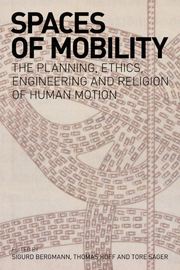Book contents
- Frontmatter
- Contents
- List of illustrations and tables
- Contributors
- Preface
- Acknowledgements
- 1 The beauty of speed or the cross of mobility? Introductory reflections on the aesth/ethics of space, justice and motion
- Part I
- Part II
- 5 The bodily basis of control in technically aided movement
- 6 What modes of moving do to me – reflections on technogenic processes of identification
- 7 Global vagabonds, place and the self: the existential dimension of mobility
- Part III
- Index
5 - The bodily basis of control in technically aided movement
from Part II
- Frontmatter
- Contents
- List of illustrations and tables
- Contributors
- Preface
- Acknowledgements
- 1 The beauty of speed or the cross of mobility? Introductory reflections on the aesth/ethics of space, justice and motion
- Part I
- Part II
- 5 The bodily basis of control in technically aided movement
- 6 What modes of moving do to me – reflections on technogenic processes of identification
- 7 Global vagabonds, place and the self: the existential dimension of mobility
- Part III
- Index
Summary
Introduction
Human society is highly dependent on the existence and use of technical transportation devices. Goods are transported long distances by large cargo ships or by airplane. People commonly use trains, buses or commercial aeroplanes for personal transport. Technical transportation vehicles allow for longer and faster movement than would be possible by foot or on horseback. Thus, cars, trains, boats and aeroplanes result in efficiencies in speed and ability to carry cargo, benefits that have seemingly led society to depend on these tools to maintain its current standard of living. This need for efficiency brings about a search for something that is more efficient than humans themselves: we strive for the possibilities and promises provided by technology.
The use of transportation technologies is steadily increasing. Norway, a country with about 4.6 million inhabitants, had about 2.3 million vehicles in 1991, a number that had increased to 2.8 million by 2000. The number of kilometres driven on Norwegian roads has increased by approximately 13 per cent in the decade from 1990 to 2000, from 48 billion km to 54 billion km respectively (Statistics Norway 2002). This increase is a part of a global trend, which results in pollution that threatens the natural environment (see Holden, this volume, Ch. 3). In addition to the negative effects from pollution, transport also entails global threats to humans in terms of deaths and injuries. The first automobile accident occurred in 1869, when a young woman was crushed to death under the wheels of a steam-carriage (Fallon & O'Neill 2005).
- Type
- Chapter
- Information
- Spaces of MobilityThe Planning, Ethics, Engineering and Religion of Human Motion, pp. 101 - 124Publisher: Acumen PublishingPrint publication year: 2008

